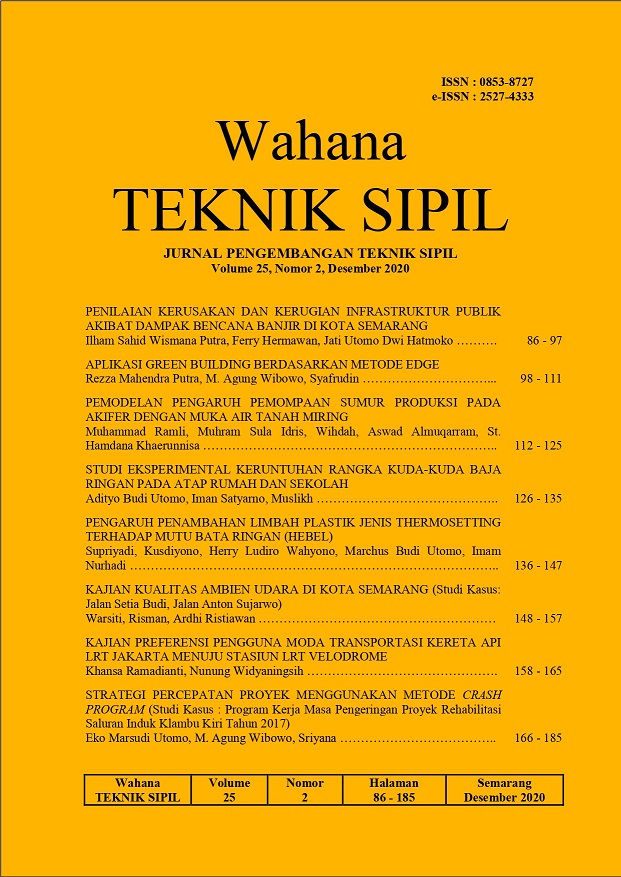STRATEGI PERCEPATAN PROYEK MENGGUNAKAN METODE CRASH PROGRAM (Studi Kasus : Program Kerja Masa Pengeringan Proyek Rehabilitasi Saluran Induk Klambu Kiri Tahun 2017)
DOI:
https://doi.org/10.32497/wahanats.v25i2.2163Keywords:
Main channel”™s rehabilitation, drying period, acceleration, crashing methodAbstract
Based on the initial plan from the contract of the Rehabilitation Klambu Kiri”™s Project, main channel's work was carried out continously by an open and closed system using the kistdam method. However by the time of execution work, the stakeholders wanted the work in the main channel to be carried out based on cropping pattern, where there a drying period and a drainage period. In this case, flow area and bottom structure of the channel can only be worked during the drying period lasting three months. To be able to determine the impact of these change, a duration calculation is carried out from project's data which are internal's BQ, initial plan's resources, and the relations between activities using Microsoft Project on the flow section structure which be worked in drying period of 2017. The normal duration obtained from analysis is 203 days. It was exceeded time of drying period and possibly could have an impact on the overall project completion schedule resulting in delays, defaults and even termination of contracts. Therefore, it is necessary to have an accelerate strategy of the work on the flow section structure to be completed within a predetermined time. In this study, the acceleration strategy was carried out using crashing analysis in the critical activities from normal duration using Microsoft Project. The crashing method was carried out in stages from the crashing simulation of 30 days, 60 days, to 120 days so that obtained the duration of acceleration was 83 days. The cost component of acceleration is calculated by choosing the lowest cost from the alternatives of increasing work hours (overtime) or by adding resources. From the simulation results, the crash cost to complete the acceleration work is Rp. 1.298.307.591,- or about 2,05% of direct cost, so the efficiency is Rp. 9.692.409,- from normal durationReferences
Adi, R.R.B., Traulia, D.E., Wibowo, M.A., Kistiani, F., 2016, Analisa Percepatan Proyek Metode Crash Program Studi Kasus: Proyek Pembangunan Gedung Mixed Use Sentraland, Jurnal Karya Teknik Sipil
Volume 5 Nomor 2 Tahun
, hal 148-158
Husen, A., 2013, “Duration-Cost Trade Off” Sebagai Solusi Mengatasi Keterlambatan Waktu di Proyek, Jurnal IPTEK, Volume 8, Nomor 1,
April 2013. hal 7-15
Kepmenakertrans, 2004, Keputusan Menteri Tenaga Kerja dan Transmigrasi Republik
Indonesia Nomor Kep.102/Men/VI/2004 tentang Waktu Kerja Lembur dan Upah Kerja Lembur, Menakertrans, Jakarta
Pawiro, D.A., Suharyanto, Atmojo, P.S., 2014, Optimalisasi Biaya dan Waktu dalam Penyusunan Jadwal Pelaksanaan Proyek
(Studi Kasus Proyek Pembangunan Gedung Pusat Kegiatan Mahasiswa
Universitas Diponegoro Semarang), Jurnal Media Komunikasi Teknik Sipil, 20(2), pp. 103-108
Yoni, I.A.M., Warsika, I.P.D, Sudipta, I.G.K., 2013, Perbandingan Penambahan Waktu Kerja (Jam Lembur) Dengan Penambahan Tenaga Kerja Terhadap Biaya Pelaksanaan Proyek Dengan Metode Time Cost Trade Off (Studi Kasus Proyek Pembangunan Gedung Instalasi Farmasi Blahkiuh), Jurnal Ilmiah Teknik Sipil Vol. 17, No. 2, hal 129-138.
Downloads
Published
Issue
Section
License
Authors who publish with this journal agree to the following terms:Authors retain copyright and grant the journal right of first publication with the work simultaneously licensed under a Creative Commons Attribution License that allows others to share the work with an acknowledgement of the work's authorship and initial publication in this journal.
Authors are able to enter into separate, additional contractual arrangements for the non-exclusive distribution of the journal's published version of the work (e.g., post it to an institutional repository or publish it in a book), with an acknowledgement of its initial publication in this journal.
Authors are permitted and encouraged to post their work online (e.g., in institutional repositories or on their website) prior to and during the submission process, as it can lead to productive exchanges, as well as earlier and greater citation of published work (See The Effect of Open Access).






